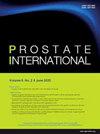Effects of bladder neck sparing on continence outcomes of robotic-assisted radical prostatectomy: a systemic review and metaanalysis
IF 2.6
2区 医学
Q2 UROLOGY & NEPHROLOGY
引用次数: 0
Abstract
Restoration of postoperative urinary continence after robot-assisted radical prostatectomy (RARP) is affected by diverse factors. We compared the pad-free and positive margin rates of patients who underwent RARP with or without bladder neck sparing (BNS) for prostate cancer. During this systematic review and metaanalysis, we performed an electronic search of the Web of Science, Embase, Cochrane Central Register of Controlled Trials, and PubMed to find original articles comparing RARP with and without BNS for prostate cancer. We identified six studies (2,351 patients in total) who underwent RARP with or without BNS. A metaanalysis of the pad-free rate at 3 months was performed. The overall pad-free rate at 3 months for patients who underwent RARP with BNS was significantly higher than that of patients who underwent RARP alone (control group) (odds ratio, 1.86; 95% confidence interval [CI], 1.22–2.82), with high heterogeneity (P = 0.005; I2 = 67.45%). The pad-free rates at 7 days, 6 months, and 1 year and positive surgical margin rates of patients who underwent BNS were not significantly different than those in the control group. Although no statistical difference was observed, the catheterization period of the BNS group was shorter than that of the control group (standardized mean difference = −0.08; 95% CI, −0.16 to 0.01). Although RARP with BNS did not affect the long-term outcome of continence, it had a significant effect on the early recovery of continence.
保留膀胱颈对机器人辅助根治性前列腺切除术尿失禁疗效的影响:系统回顾与荟萃分析
机器人辅助前列腺癌根治术(RARP)术后恢复排尿受多种因素影响。我们比较了接受或未接受膀胱颈疏通术(BNS)的前列腺癌根治术患者的无尿垫率和阳性边缘率。在这项系统回顾和荟萃分析中,我们对 Web of Science、Embase、Cochrane Central Register of Controlled Trials 和 PubMed 进行了电子检索,以找到比较前列腺癌 RARP 有无 BNS 的原始文章。我们找到了六项研究(共 2351 名患者),这些患者接受了有无 BNS 的 RARP 治疗。我们对 3 个月的无衬垫率进行了荟萃分析。接受 RARP 和 BNS 治疗的患者 3 个月后的总无垫率明显高于单纯接受 RARP 治疗的患者(对照组)(几率比 1.86;95% 置信区间 [CI],1.22-2.82),异质性较高(= 0.005;I = 67.45%)。接受 BNS 治疗的患者在 7 天、6 个月和 1 年后的无衬垫率以及手术切缘阳性率与对照组相比没有显著差异。虽然没有观察到统计学差异,但 BNS 组的导管插入时间比对照组短(标准化平均差异 = -0.08;95% CI,-0.16 至 0.01)。虽然使用 BNS 的 RARP 并不影响排尿的长期效果,但对排尿的早期恢复有显著影响。
本文章由计算机程序翻译,如有差异,请以英文原文为准。
求助全文
约1分钟内获得全文
求助全文
来源期刊

Prostate International
Medicine-Urology
CiteScore
4.40
自引率
26.70%
发文量
40
审稿时长
35 days
期刊介绍:
Prostate International (Prostate Int, PI), the official English-language journal of Asian Pacific Prostate Society (APPS), is an international peer-reviewed academic journal dedicated to basic and clinical studies on prostate cancer, benign prostatic hyperplasia, prostatitis, and ...
 求助内容:
求助内容: 应助结果提醒方式:
应助结果提醒方式:


